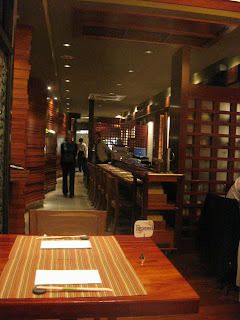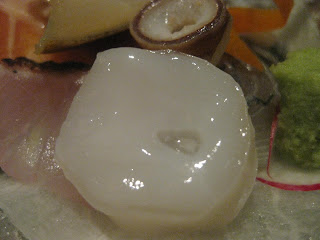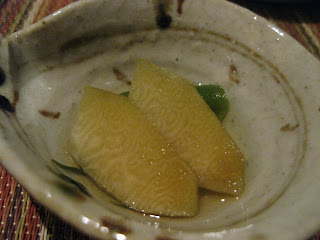Kaiseki. A simple yet mysterious word to most Americans, "kaiseki" refers to a traditional Japanese multi-course meal emphasizing only the freshest seasonal ingredients served in various preparations. I've been puzzled by the lack of New York restaurants specializing in kaiseki considering America's fascination with "omakase," the Japanese equivalent to a tasting menu.
My initial kaiseki experience was at a ryokan, or a traditional Japanese inn, in Kyoto, Japan. Upon my return to Tokyo, I was fortunate enough to try a modern-day interpretation of a kaiseki meal at Nihonryori RyuGin (Two Michelin Stars) and was blown away by the exotic ingredients, stunning presentations and incredible flavors. So when I read about Kyo Ya, an almost hidden gem of a restaurant specializing in kaiseki, my reservation was all but booked.
Kyo Ya requires at least two days notice for a kaiseki meal. This ensures that the restaurant will be able to obtain all of the ingredients required for the meal, with a majority of them coming straight from Japan. Though I was conscientious of my carbon footprint, any, if not all of these thoughts were immediately vanquished upon my first bite. The initial, and perhaps most difficult task for dining at Kyo Ya is actually finding the restaurant. Like many other reviewers have chronicled, the restaurant is virtually undetectable to the untrained eye. A mere "open" sign signals patrons to a stairwell leading to the restaurant's subterranean entrance. Upon entering the doors, MW and I were greeted with a Japanese welcome as the smell of incense engulfed us while we were led to a table with a "reserved" sign on it. Printed menus of the meal were placed before us, intricately detailing the different ingredients and courses we were about to enjoy.
MW and I decided to start the evening like many we had enjoyed in Japan, with a bottle of sake. Seeing that we had requested the kaiseki menu, our waitress recommended a bottle of the Masumi "Arabashiri," Nama Ginjo from the Nagano Prefecture of Japan. Considered a young sake, MW and I enjoyed the cold and crisp flavor of the sake and thought it paired exceptionally well with our meal.
Our first course or "Zatsuki" consisted of a Crispy Fried Rolled Bread with Shrimp Mousse. Similar to a shrimp toast, the shrimp mousse had been stuffed inside a perfect piece of fried bread and was a great start to our meal. Although deep fried, the bread wasn't the least bit greasy and the subtle seasoning allowed the natural sweetness of the shrimp to shine. We both agreed that it went very well with the sake and would be a great drinking food.
Next was the "Sakizuke" course which traditionally is a seasonal appetizer that combines elements from the sea and mountains. Presented before us was a striking presentation of Jade Egg Plant combined with Sea Urchin in a "Dashi" Jelly. MW and I thoroughly enjoyed this course as the briny uni mixed flawlessly with the savory eggplant and rich dashi jelly.
Our "Oshinogi" or bite-sized food, similar to an amuse bouche, were two balls of Sticky Rice Filled with Scallop, Topped with Fish Roe and a Nori Sauce. This course reminded me of the scallop sushi that MW and I enjoyed at Sushi Yasuda, as the sweetness of the scallop lingered on your tongue after each bite.
We were then presented with a lidded bowl. The menu indicated this was our "Owan" course, which typically consists of a soup with ground fish meat. Ours held a Green Pea Mousse mixed with Red Snapper in a Clear Soup. The mousse had a subtle flavor and an interesting texture-- similar to a fish tofu that MW and I eat with Chinese hot pot.
The "Zensai," or appetizer course was presented on a large plate with five different items: Chilled Berkshire Pork "Shabu Shabu" in a House Made Mayonnaise and Onion Sauce; Fried Portabello Mushrooms in a "Dashi" Sauce Topped with Bonito Flakes; Japanese Summer Fish (Ayu) and a Pumpkin Tempura; Noodle Like Seaweeds from "Noto," Japan with a Dashi and Lemon Dipping Sauce and a Brussels Sprout and Blue Shrimp with Tofu Sauce. The sweet pumpkin tempura and seaweed that mimicked soba noodles were my favorite among the appetizers, though I didn't find any to be unsuccessful.
The sixth course was the "Otsukuri" or the sashimi of the day, which the chef selected. We started with a single Botan Shrimp served with a Teriyaki Sauce. Like the other dishes, the shrimp was impeccably cooked showcasing its sweetness. We were instructed not to eat the head and were pleasantly surprised when it was returned after being deep-fried. Deep Fried Shrimp Heads are my favorite parts of the animal and possess a highly concentrated flavor, like a more intensely flavored prawn cracker.
The remainder of the sashimi course was displayed in one of the most beautiful presentations I've ever seen. A hollowed out ice sphere housed pieces of: Tako (Octopus) from Hokkaido, Ibodai (Japanese Butterfish), Maguro (Bigeye Tuna), Tai (Red Snapper), Awabi (Abalone), Masu (Tasmanian Trout) and Hamachi (Yellowtail). Accompanying the seafood was some Fresh Wasabi, Wakame Salt, House Made Soy Sauce and a Pepquiño (a small cucumber/melon from South America). All of the sashimi tasted incredibly fresh and was superb when eaten with the fresh wasabi.
The "Shiizakana" or main course was a play on the western "Surf-N-Turf. The "surf" was a Soft Shell Crab Teriyaki with Cauliflower and a Sun Dried Tomato Puree. MW and I both relished this seasonal treat and were impressed how the sauce enhanced the flavor of the crab.
The "turf" portion of the dish consisted of three pieces of Grilled Tajima Beef, a domestic variety of Wagyu, and made for a delicious and proactive portion of the meal. We were instructed to use a piece of the beef fat to lubricate and grill the meat on a giant rock heated from a box containing hot coals that was placed before us. While not as delectable as the A5 Kobe beef I enjoyed in Japan, the quality of this beef was outstanding, as seen by the highly marbled exterior, and only required a sprinkling of salt to enjoy.
After the grilled "Shiitzakana" course came the "Nomono," or simmered course. Ours consisted of Simmered "Anago" Wrapped with Daikon Radish in a Crystal "Sakura" Shrimp Broth. Simmered daikon radish was cut thin and was wrapped around delicate anago or eel. The daikon had taken the flavor of the broth which was infused with a sweet shrimp flavor from the "sakura" or tiny pink shrimp.
Following the main course was the "Tomezakana" with "Junsai" Water Shield with CoCo Tomato in a Vinegar Sauce. I was impressed with the inclusion of the junsai, or water shield ingredient in this "salad," seeing how I've only seen this once before in Japan. MW and I liked this dish and felt it was a nice palette cleanser, with the acidity of the vinegar sauce cleansing the fattiness of the beef.
As with any traditional Japanese meal, our last savory course ended with rice, pickles and miso soup. The "Oshokuji" course consisted of Kamadai Rice cooked in a Clay Pot with Salmon and Enoki Mushrooms, Miso Soup and Pickles of the Day (Squash and Green Beans). Those of you who read my earlier Zenkichi post know that I'm a huge fan of ending my meals with this combination. Kyo Ya's version was simply incredible. The miso soup had a fuller flavor than most other variations, the pickles were impeccably fresh and the rice mixed with salmon and mushrooms created a umami-like effect in the mouth.
The first dessert was a Cream Cheese Pudding with Seasonal Fruit (Strawberries and Kiwi). The pudding was extremely creamy and was reminiscent of a lighter cheesecake, pairing well with the tart yet sweet fruit. My only complaint was that the caramel sauce on top of the pudding was a bit burnt and tasted bitter.
Our final dessert was a "Shiso" Mint Leaf Sorbet. The shiso flavor was clearly evident, which was fine for those who enjoy its flavor (me) but was a bit overpowering for others (MW).
Sometimes a meal is more than the food placed before you. These meals transcend being simply nourishment and instead, have the ability to transport you to a different place. When I initially made reservations and requested the kaiseki meal at Kyo Ya, I sought a refuge from the hectic Manhattan grind. Every aspect of Kyo Ya impressed me, from the incense-scented bathrooms, to the Japanese salary men that comprised the majority of the restaurant and took me back to Kyoto. If a transformative meal like this appeals to you, take my advice and experience kaiseki at Kyo Ya.
Kyo Ya
94 East 7th Street
New York, NY 10009
(212) 982-4140
http://nymag.com/listings/restaurant/kyo-ya/
To see all our pics please click the flickr link.













































The beauty of this restaurant is how the menu is ALWAYS different. Looking at your review makes me want to go back again.
ReplyDelete@ EatBigApple: Glad you enjoyed the review...I was very impressed with the quality of food here. I've also heard very good things about Sugiyama's Kaiseki meal and will have to try that another time.
ReplyDeletemy last meal @ Sugiyama was very disappointing. this meal looks *much* more refined and in spirit w/ the kaiseki you experienced in Kyoto. this looks very very good - adding it to the itinerary.
ReplyDelete@ChuckEats: thanks for the intel regarding Sugiyama. Glad I could point you in the right direction when you visit NYC again, though, it still wasn't half as good as what I enjoyed in Japan.
ReplyDelete